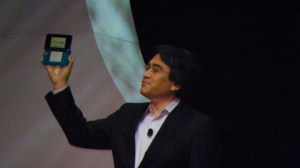When Peter and I got to the Nintendo meeting rooms behind the Japanese gaming giant’s huge E3 booth, Satoru Iwata was pecking away at one of Apple’s Macbook Pro laptops. He folded it shut and quickly stood up to greet us, but I found it telling that the president of Nintendo’s worldwide operations would be using a Cupertino-built computer.
Both companies get criticized for the way they tease and tantalize their faithful, and get accused of dumbing down their products to make them more blatantly commercial. But, critics of both companies have had to stand by while both became dominant in their respective arenas. Yes, Nintendo and Apple are circling each other warily in the handheld gaming market, but Nintendo’s been top dog in that section of video games for more than two decades. Their latest portable, the depth-centric 3DS, may just be the key to extending that supremacy.
Iwata talked about the 3DS and more during our chat, going deep into how Nintendo develops products, what he sees as the company’s core mission and the things that frustrate hardware engineers who work at the House of Mario. President of Nintendo since 2002, Iwata-san rarely gives interviews to American media outlets and we think that his comments should shed some significant light onto the guiding principles of Nintendo as a company. Read on to hear from the man guiding the biggest video-game company in the world.
I think usually the perception is that Nintendo holds back to kind of keep fans interested and anticipating. I was not expecting to see quite so many titles announced at the press conference this year. What was the decision behind announcing so much this year?
Well, we reviewed what we could learn from the past few years. Most specifically, we reviewed what our customers’ expectations were towards Nintendo’s E3 presentation. These lessons affected how Nintendo presented some of our games this year.
Also, our key appeal yesterday during our E3 presentation was without any doubt the 3DS. At the early stage of thinking of how to structure the presentation, we decided we really wanted to show the Nintendo 3DS at the tail end. When we thought about how should we construct the flow, it was relatively easy for us to lead with software. It appeared that so many people were excited with our announcement yesterday, so at least I’m very glad about that.
I think what surprised people was the ability to get to see it and get hands-on with the 3DS right away. What was the decision-making process behind that?
We’ve been thinking very carefully about how can we possibly communicate the real value and the attraction of Nintendo 3DS. The conclusion was that there is no other way than to let as many people as possible to actually see it. We really wanted to have the 3DS available at the tail end of our E3 briefing and decided that the very end of the presentation would be an actual hands-on.
(More on Techland: Nintendo Makes the 3DS Official, No Goofy Glasses Required)
So is this pretty much what the unit is going to find the production unit is going to look like?
This is still not the final exterior design. We’re anticipating some minor modifications. I’m not anticipating major changes from this but there may still be some minor changes.
It seems as though in the last few years with Nintendo’s handhelds, the product roadmap has been pretty accelerated. You have the DSi and then the XL and now the 3DS. Is there a specific reason why you’ve rolled out so many different handhelds in the last two or three years? Is it to combat other handheld gaming devices and other things like the iPhone?
At Nintendo, we have never thought that way. For example, from the original DS to the DS Lite, there’s just some minor functionality differences. But, then, you see the difference from the DS Lite and DSi transition. That kind of transition involved several major functionality additions. And as you noted, the DSi to DSi XL transition has simply the slightest difference, with the better view angle. We’re bulding variety, as with different color variations for the hardware. That’s our basic understanding towards how we approach the new iterations with the same functions.
In the case of the Nintendo 3DS, it’s supposed to be the successor to Nintendo DS. As soon as the development of the original Nintendo DS was over, we started working on the successor to it. We’ve already spent six years in order to develop this Nintendo 3DS. In other words, the development of the successor or Nintendo 3DS has been taken on in parallel with working on the additional new models and new colors to the Nintendo DS.
So, are you saying that the research for the 3DS doesn’t build off of previous DS iterations? Or was it a separate project?
Separate.
Okay, separate project. For six years, then, you guys have been thinking about the idea of 3D on a handheld?
I’m sorry; I might have confused you. When we first considered the successor for the Nintendo DS, we didn’t come up with 3D as the first and foremost idea to be incorporated. Rather, we first tackled much broader concepts like the processing power, what kind of graphics capability the successor will be able to have and thinking ahead to what kind of new functionality should be available for the gaming device. Those basic concepts came first.



